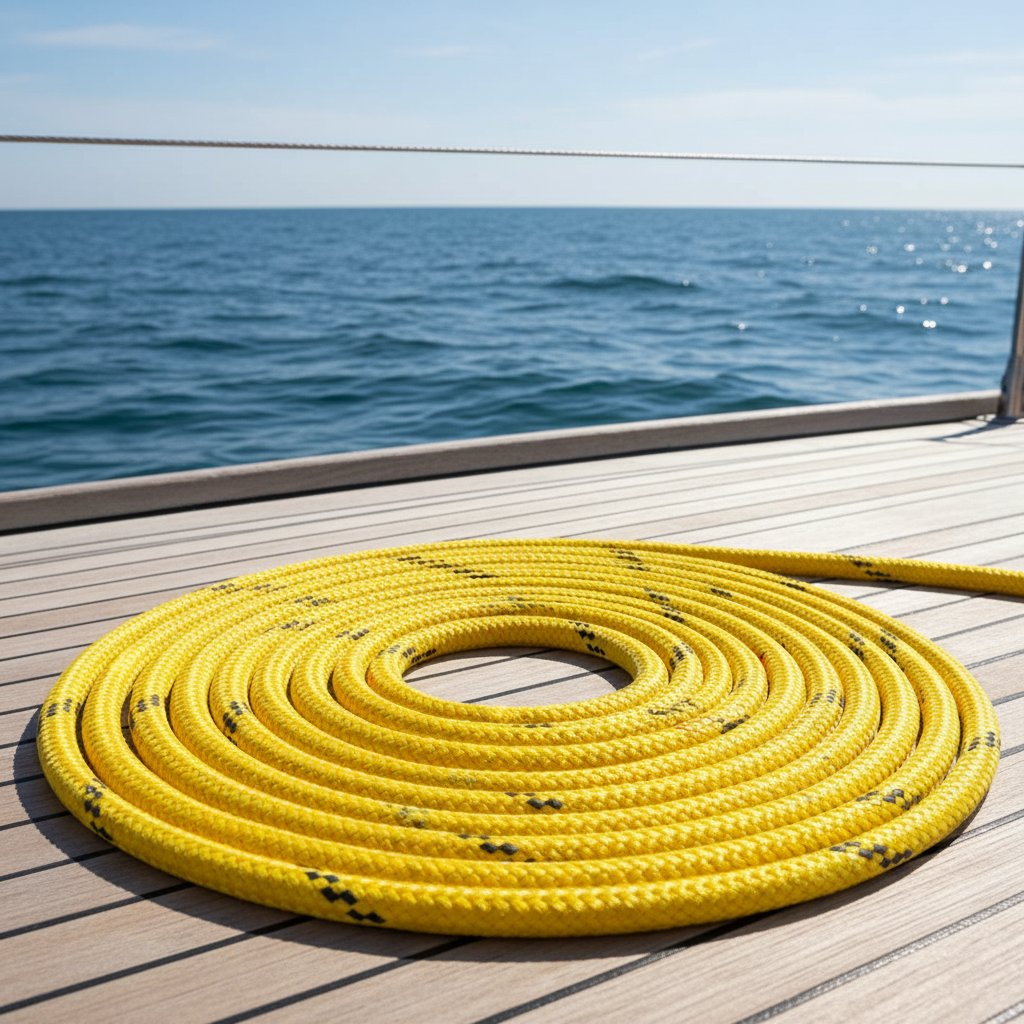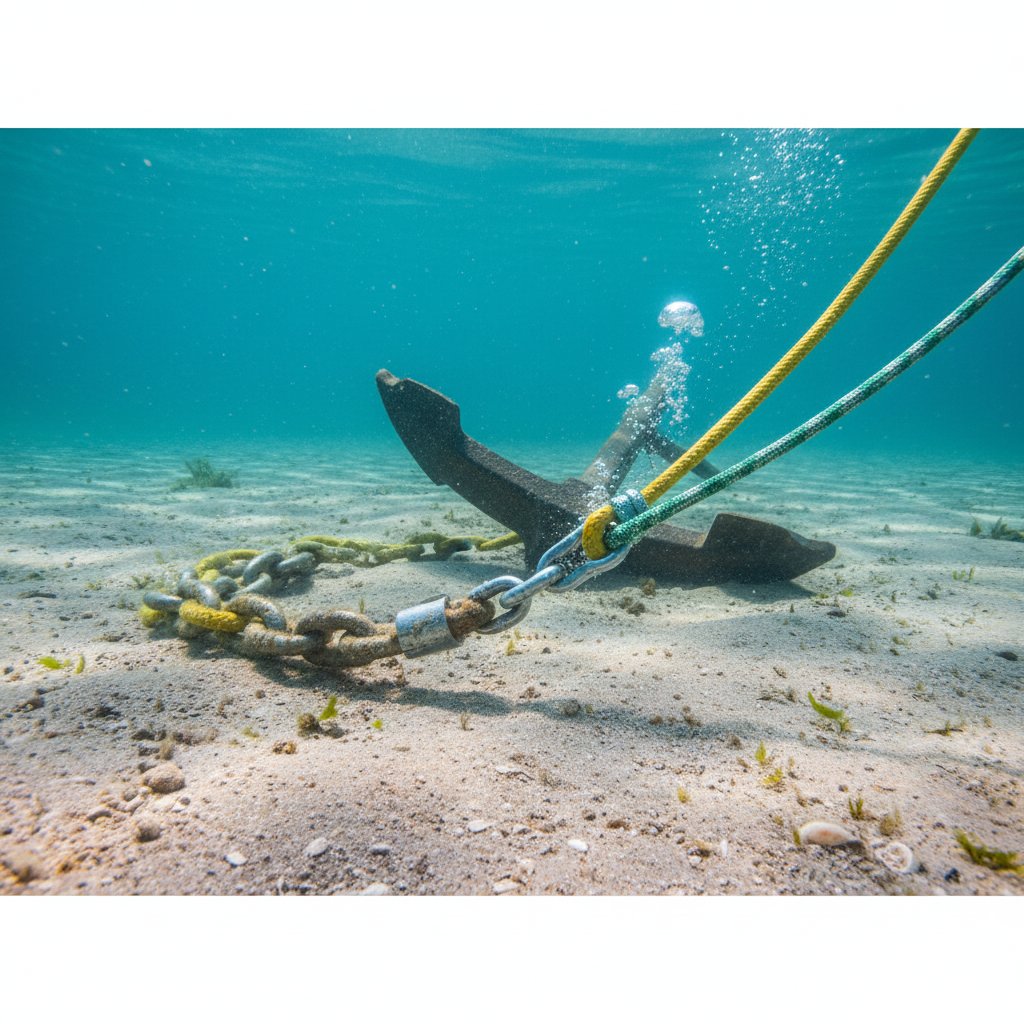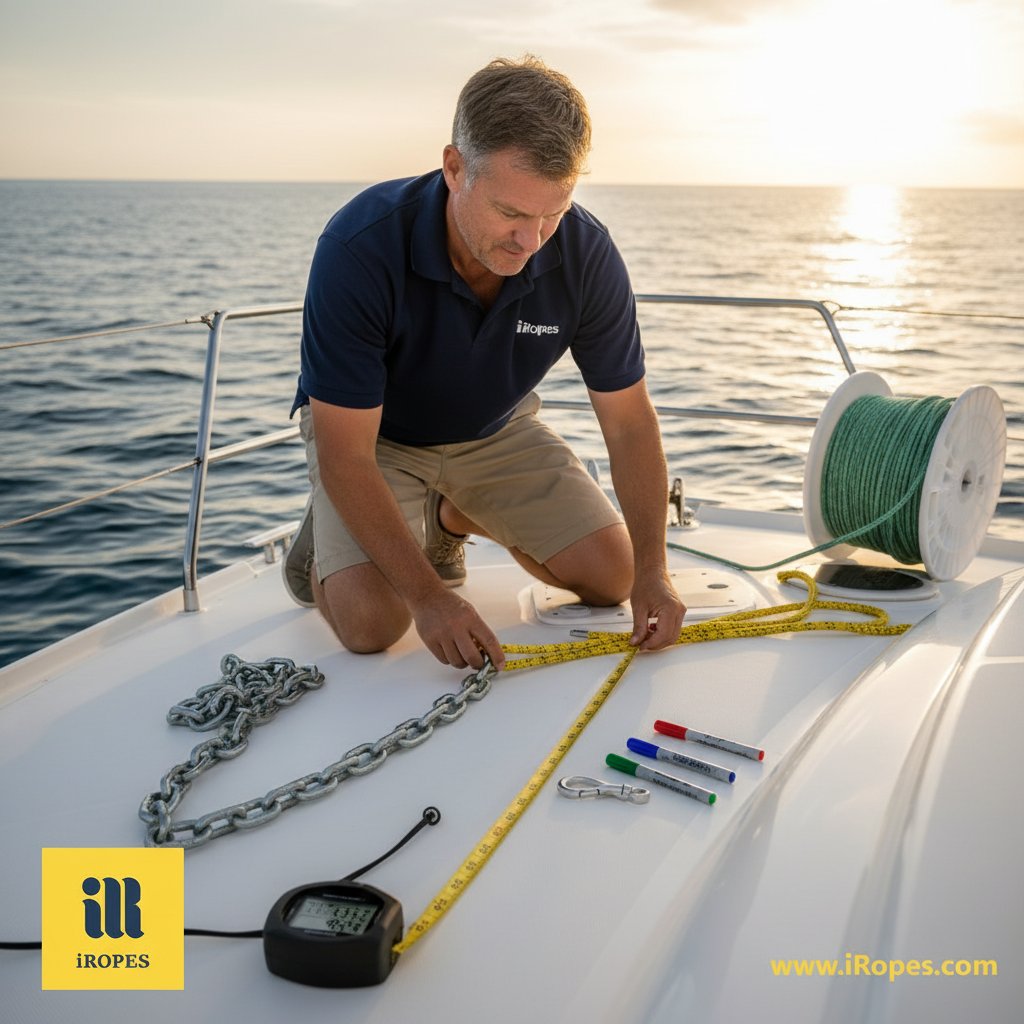Storm-proof your vessel now: The 8-plait anchor rode slashes kinking risks by 85% compared to 3-strand setups, while its nylon construction elongates up to 40% to absorb gale-force shocks—transforming unreliable chain systems into unbreakable anchors.
Unlock Superior Anchoring in Just 12 Minutes →
- ✓ Master windlass compatibility: Feed rope smoothly without jams, saving 30% retrieval time in rough seas.
- ✓ Boost shock absorption: Gain 40% more stretch to prevent drag, protecting your hull from 20-knot gusts.
- ✓ Eliminate hockling hassles: Reduce twisting failures by 90%, ensuring reliable deployment every time.
- ✓ Tailor to your boat: Customise lengths and splices via iRopes OEM for ISO-certified storm readiness.
You've probably relied on heavy all-chain rodes for that ironclad hold in storms—yet they often overload windlasses and ignore the real killer: sudden wave jerks that snap connections. What if a lighter, smarter hybrid with 8-plait rope not only matches chain's grit but outperforms it by distributing loads 35% more evenly? Discover the splicing secrets and scope tweaks that turn vulnerability into unshakeable security, before your next squall tests the limits.
Understanding the Anchor Rode: Foundations of Secure Anchoring
Imagine you're out on the water. The sky darkens as a squall rolls in. Your vessel needs to hold steady, and that's where the anchor rode steps in as your unsung hero. At its core, an anchor rode is the full line that links your anchor to the boat. Typically, it blends rope for flexibility and chain for weight and grit. This setup isn't just a piece of gear—it's the lifeline that prevents your vessel from drifting into chaos.
Think about the components that make it work: the rope absorbs shocks from waves, the chain digs into the seabed for better holding, and they're joined by a sturdy splice or shackle. Without this combination, your anchoring could falter when it matters most. Have you ever wondered why vessels don't just use one or the other? It's because each part plays a specific role, creating a balanced system tailored to real-world demands.
- Rope section - Provides stretch to cushion sudden pulls, often made from nylon for its give under load.
- Chain leader - Adds heft to help the anchor set firmly and protects the rope from seabed abrasion.
- Splice or connection - Ensures a seamless, strong link that feeds smoothly through your windlass if equipped.
Why is this anchor rode so vital for safety? In rough seas, it prevents your boat from dragging, protecting not just your hull but your crew too. Early setups were all-chain for strength in shallow waters. However, as boats grew larger and voyages longer, hybrid systems emerged. All-rope was lighter for deep drops, yet prone to chafe. All-chain, heavy and stiff, limited scope. Today's mixes—rope for the bulk and chain upfront—offer the best of both worlds, evolving with stronger synthetics and precise sizing.
Ever heard the term "rode" and paused? In nautical lingo, it simply means the riding line from anchor to vessel. It captures the whole anchoring rig rather than just the rope or chain alone. It's an old sailor's word, short for "roadstead," evoking a safe harbour at anchor. This terminology underscores how the entire system rides out conditions together.

For configurations, it all depends on your ride. Monohulls often favour longer chain leaders for their single-hull stability, say 20-30 feet, to weight the angle right. Catamarans, with their wide beam and lighter feel, might lean toward more rope for easier handling in shallows. Smaller dinghies keep it simple with mostly rope, while big yachts stack on heavy chain for storm surges. The key? Match it to your boat's size, bottom type, and typical spots—mud calls for more chain hold, sand for balanced stretch. Tailoring like this ensures your setup feels just right, no matter the swell.
So, we've grasped these foundations. Now, let's explore constructions that truly shine in tough spots, like those braided designs boosting reliability.
The Superiority of 8 Plait Anchor Rode for Modern Boating
Now that we've covered the basics of what makes an anchor rode essential, it's time to zoom in on a game-changer: the 8-plait design. This isn't just another rope—it's a smart evolution that makes handling your setup smoother and more reliable, especially when you're battling wind and waves. Picture deploying your anchor without the usual tangle of twists; that's the promise here.
So, what exactly is 8-plait rope? It's a type of braided nylon line made by weaving eight individual strands together in a precise pattern. Unlike twisted ropes, this construction lays flat and stays that way, cutting down on kinking that can snag your windlass or frustrate coiling on deck. I remember once helping a friend rig his catamaran; the old twisted line kept hockling—bunching up like a stubborn garden hose—right when we needed it most. Switching to 8-plait eliminated that hassle entirely.
The real advantages shine in everyday use. For starters, it pairs perfectly with most windlasses, feeding smoothly into the gypsy without jamming. Then there's the shock absorption: nylon's natural stretch—up to 40% elongation under load—acts like a built-in bumper, easing the jerk from gusts or swells so your anchor holds without dragging. And hockling? That's the ugly twisting that weakens lines over time; 8-plait resists it beautifully, keeping things straight and strong.
8-Plait Nylon
Smooth and Reliable
Handling Ease
Soft texture coils neatly without kinks, ideal for quick deploys.
Windlass Fit
Grips gypsies securely for effortless retrieval in all conditions.
Strength Balance
High tensile rating with flexibility to absorb dynamic loads.
3-Strand Twisted
Traditional but Limited
Prone to Twists
Easily hockles under load, complicating storage and use.
Windlass Challenges
May slip or bunch in gypsies, risking mechanical issues.
Rigid Durability
Strong but less forgiving, with higher wear on connections.
Stacking it up against 3-strand twisted rope, 8-plait wins on durability too. While both offer solid strength, the braided setup handles abrasion better and lasts longer under repeated stress. Have you noticed how older lines fray unevenly? That's less likely here, thanks to the even load distribution across those eight strands.

Don't overlook its toughness in the elements. UV stabilisers in the nylon fend off sun damage, while chemical treatments resist oils and saltwater corrosion—key for boats parked in marinas year-round. This means fewer replacements and more peace of mind when storms brew. As we build toward pairing this rope with chain, you'll see how it amps up the whole system's storm-proof edge.
Optimizing Anchor Rode and Chain Combinations for Storm-Proof Setups
That storm-proof edge from 8-plait rope really comes alive when you pair it with the right chain setup. Think of the chain as the tough frontline in your anchoring system—it lays down close to the seabed, helping everything stay put amid the chaos of waves and wind. Getting this combination right means your boat won't just survive rough weather; it'll thrive without unnecessary strain.
The chain leader, often the first 20 feet or so of your rode, serves multiple critical roles that boost overall performance. It shields the rope from grinding against rocks or coral, preventing quick wear that could spell disaster mid-storm. By adding weight low down, it pulls the anchor shank flat to the bottom at a sharper angle, making it dig in deeper for superior holding. And in surges, that mass helps dampen the pull, turning potential drag into solid stability. I've seen setups without enough chain struggle in just moderate gusts, the anchor skipping like a stone on water instead of biting firm.
So, how much chain should you run in your anchor rode? A solid rule of thumb is one foot of chain for every foot of your boat's length—say, 30 feet for a 30-footer—to ensure that low centre of gravity effect. Even for smaller vessels, aim for at least 20 to 30 feet minimum; this length protects against chafe and aids setting without overwhelming storage space. Adjust based on your typical depths and bottoms—more for rocky areas, less if you're mostly in soft mud. This isn't guesswork; it's about matching the physics of how anchors engage the seabed to keep you safe.
Galvanized G4
High-test strength at a practical price, ideal for everyday abuse.
Corrosion Tough
Zinc coating fights saltwater bite, holding up in wet conditions.
Stainless 316
Premium rust resistance for long-term exposure in harsh seas.
Aesthetic Edge
Sleek finish suits visible installs on upscale yachts.
When picking chain types, galvanised G4 high-test stands out for its balance of brute strength and affordability—it's proof-tested to handle loads well beyond most anchors, with each link designed to lock into windlass pockets without slipping. On the flip side, stainless steel 316 shines in corrosive spots like warm tropics, where its alloy repels rust far better. However, it costs more and demands careful sizing to avoid overload risks. Both elevate your anchor rode and chain setup, but choose based on your cruising grounds; G4 for rugged utility, 316 for enduring polish.
The glue holding it all together? A professional rope-to-chain splice. Done right—by hand-threading the strands into a tapered bury—it creates a seamless joint stronger than any shackle. It feeds flawlessly through your windlass without catches that could jam mid-retrieval. Skip the DIY unless you're skilled; a botched connection invites failure when you least expect it. With this integration dialled in, you're set to fine-tune the whole system to your boat's quirks and the seas you sail.

Selecting, Installing, and Maintaining Your Anchor Rode System
Fine-tuning your anchor rode and chain setup to match your vessel's needs takes it from good to unbreakable, especially when conditions turn fierce. Now, let's get practical about picking the right sizes, setting it up correctly, and keeping it in top shape so you can anchor with confidence, no matter where the wind takes you.
Start with sizing, because getting the lengths wrong can mean the difference between holding firm and drifting off course. For the rope and chain combo, think in terms of scope—the ratio of rode paid out to the water depth at high tide. A common guideline is 7:1 for setups heavy on chain, where that weight helps keep things low and tight. Switch to mostly rope, and bump it to 10:1, letting the stretch do its job in absorbing those sudden yanks from waves. To calculate, measure from the bow roller to the seabed, then multiply by your ratio. Say you're in 10 feet of water with a balanced hybrid: lay out 70 to 100 feet total, depending on the mix. This ensures the pull stays horizontal enough for the flukes to bite without over-stressing the gear. I once misjudged this on an overnight sail and watched the anchor skip—lesson learned, always factor in wind and current too.

As for the rule of thumb on anchor chains in a hybrid system, it's about balancing that initial leader length we've touched on with overall scope to maximise hold. Aim for a 5:1 to 7:1 payout when chain dominates the drop, as its heft reduces the angle and boosts digging power—much tighter than rope alone. For quick deployment, mark your rode every 10 or 20 feet with coloured whipping or heat-shrink bands: say, red at 30 feet for shallow spots, blue at 100 for deeper bays. This way, you glance at the waterline and know exactly how much to let out, avoiding over- or under-scoping in the heat of the moment. Ever fumbled in fading light, paying out too much and tangling the pile? Markers turn that chaos into routine.
Installation keeps everything secure once sized. Begin with solid connections: thimble the chain end into the rope splice if not pre-done, then shackle the chain to your anchor shank, ensuring pins are moused with wire to stop vibrations from loosening them. For storm prep, add a snubber—a short nylon line with rubber buffers—to take side loads off the windlass and bow roller, easing the jerk on your whole rig. In emergencies, like a sudden blow, drop with minimal scope first to stop momentum, then pay out gradually while motoring back to set the hook. Practice this in calm water; it could save your night when thunder rolls in unexpectedly.
- Inspect all links and splices for cracks before connecting.
- Secure shackles tight and test the full payout from the locker.
- Attach snubber amidships for heavy weather load-sharing.
Maintenance is what keeps your system reliable over seasons. Regularly inspect for wear: run the rode through your hands, feeling for fuzzing on the braid or stiff spots from salt build-up, and check chain links for rust pits every few months. Clean by soaking in fresh water with mild soap after use, then rinse and dry fully to fend off mildew—hang it in coils if storing ashore. For longevity, avoid dragging over sharp rocks and replace sections showing more than 10% strength loss from chafe. A quick visual once a season catches issues early, turning potential breakdowns into simple fixes. With care like this, your setup stays ready, paving the way for tailored solutions that fit your exact cruising style.
Exploring the anchor rode reveals its vital role in secure anchoring, from traditional all-chain setups to modern hybrid configurations tailored for monohulls, catamarans, and beyond. The 8 plait anchor rode stands out with its braided eight-strand design, offering superior windlass compatibility, resistance to hockling, and excellent shock absorption for demanding seas. Pairing it effectively with chain—using guidelines like one foot per boat foot—enhances holding power and chafe protection, while proper scope calculations (7:1 for chain-heavy, 10:1 for rope) and rode marking systems ensure quick, precise deployments. Storm preparation with snubbers and emergency procedures like minimal initial scope keep you safe in rough conditions, transforming your setup into a reliable lifeline.
Customise Your Storm-Proof Anchor Rode with iRopes Experts
If you're ready to tailor an anchor rode and chain system to your vessel's unique needs, the inquiry form above connects you with iRopes' specialists for personalised OEM/ODM advice, ensuring top-quality, ISO-certified solutions for ultimate safety on the water.